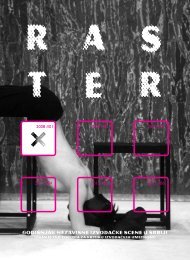Yearbook of the Independent Performing Arts Scene in Serbia - TkH
Yearbook of the Independent Performing Arts Scene in Serbia - TkH
Yearbook of the Independent Performing Arts Scene in Serbia - TkH
Create successful ePaper yourself
Turn your PDF publications into a flip-book with our unique Google optimized e-Paper software.
ary “forest artists” never<strong>the</strong>less exhibit <strong>the</strong>ir art <strong>in</strong> Belgrade and NoviSad. PBP have no artistic <strong>in</strong>fluence whatsoever on <strong>the</strong>ir local community<strong>of</strong> Gornji Milanovac. The peasants look at <strong>the</strong>m <strong>in</strong> wonder. Their lifestyle,<strong>in</strong>extricably l<strong>in</strong>ked to <strong>the</strong>ir art, meets reception only <strong>in</strong> big towns. If youask <strong>the</strong> people <strong>of</strong> Gornji Milanovac, <strong>the</strong>y will mostly refer to PBP as a “dangeroussect” or a “bunch <strong>of</strong> lunatics ga<strong>the</strong>red around that freak (BožidarMandić)”. In <strong>the</strong> Belgrade cultural habitat, PBP enjoy different acclaim. Theyperform <strong>in</strong> grand <strong>the</strong>atres and cultural <strong>in</strong>stitutions, championed by manyrelevant <strong>the</strong>atre scholars and practitioners (for example, Jovan Ćirilov,founder and selector <strong>of</strong> <strong>the</strong> Bitef Festival and one <strong>of</strong> <strong>the</strong> most <strong>in</strong>fluentialfigures <strong>in</strong> <strong>Serbia</strong>n <strong>the</strong>atre). Ćirilov calls <strong>the</strong>m, <strong>the</strong>oretically justified, “<strong>the</strong><strong>Serbia</strong>n Liv<strong>in</strong>g Theatre”… And, <strong>in</strong>deed, be<strong>in</strong>g a company function<strong>in</strong>g quiteextraord<strong>in</strong>arily, try<strong>in</strong>g to live <strong>in</strong> harmony with imperatives <strong>of</strong> ecology andnature, far from alienation, high-tech gadgets and <strong>the</strong> modern society, andpossessed by <strong>the</strong>ir commitment to cultural-political revolution <strong>of</strong> <strong>the</strong> late60s, PBP represent a unique phenomenon on <strong>the</strong> alternative <strong>the</strong>atre andartistic scene <strong>in</strong> <strong>Serbia</strong>. In <strong>the</strong>ir home, every August, <strong>the</strong>y host a festival <strong>of</strong>ecologic <strong>the</strong>atre called Šumes. So, for few days <strong>in</strong> <strong>the</strong> year, <strong>the</strong>y manage tomove <strong>the</strong> hub <strong>of</strong> alternative <strong>the</strong>atre life from Belgrade and Novi Sad to <strong>the</strong>forests on Mount Rudnik. However, <strong>the</strong> only audience <strong>of</strong> this festival ma<strong>in</strong>lycomprises its participants. In its <strong>the</strong>atre-historical context, PBP’s creativework closely relates to <strong>the</strong> notions <strong>of</strong> avant-garde. In that sense, Šumes is<strong>the</strong> most alternative <strong>of</strong> all alternative festivals <strong>in</strong> <strong>Serbia</strong>. It functions <strong>in</strong>dependentlyfrom any budget or <strong>in</strong>stitution, propelled only by <strong>the</strong> enthusiasmand energy <strong>of</strong> its supporters.Pančevo is a small town, drafted <strong>in</strong> big letters on <strong>the</strong> map <strong>of</strong> <strong>the</strong> alternative<strong>the</strong>atre <strong>Serbia</strong>. It is only 15 km away from Belgrade. In spatial terms,<strong>the</strong> town <strong>of</strong> Pančevo lies closer to downtown Belgrade than many <strong>of</strong> itsremote suburbs. However, <strong>the</strong>re are two reasons why this community willnever be Belgrade-governed. Although Pančevo is <strong>in</strong> every way connectedto Belgrade, it cherishes a quite ‘<strong>in</strong>digenous’ cultural history and tradition,<strong>in</strong> many respects more advanced than Belgrade’s, especially dur<strong>in</strong>g <strong>the</strong> XIXcentury. On <strong>the</strong> o<strong>the</strong>r hand, Pančevo is notoriously famous for be<strong>in</strong>g <strong>the</strong>most polluted place <strong>in</strong> <strong>Serbia</strong>. Oil ref<strong>in</strong>ery, fertilizer company “Azotara”and o<strong>the</strong>r Pančevo-based <strong>in</strong>dustries, do not ‘closely’ follow modern ecologicaldemands. Therefore, <strong>in</strong> Pančevo, almost every day, sirens for generalenvironmental alarm are due to be at work. Poisoned Pančevo consequentlypoisons Belgrade. However, as long as Pančevo ma<strong>in</strong>ta<strong>in</strong>s its <strong>in</strong>dependentadm<strong>in</strong>istration, Belgrade perceives <strong>the</strong> environmental collapse as be<strong>in</strong>g“somewhere else”, that it “happens to o<strong>the</strong>rs” and that “<strong>the</strong>re’s no reason







